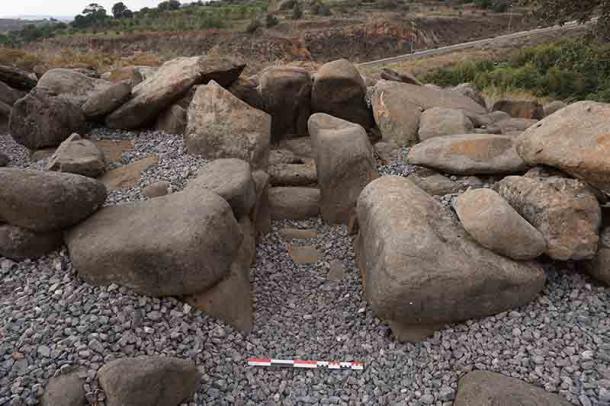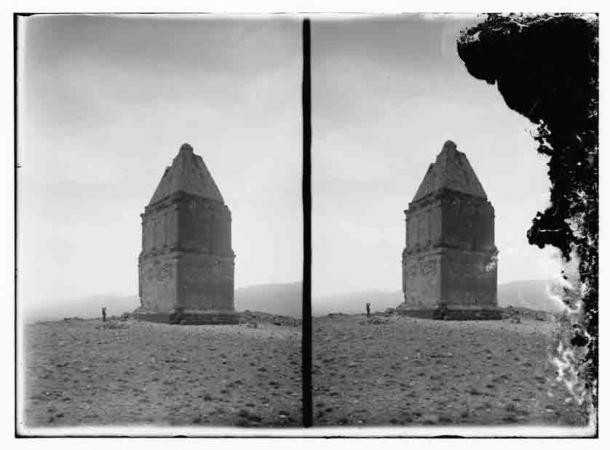An ancient pyramid-shaped megalithic burial has been discovered in North Lebanon dating back to 2,000 years before the pyramids of Egypt. What’s more, it is speculated that this, and other similar pyramid tombs in Lebanon, might have inspired the rulers of Egypt to construct their world famous pyramidal super-structures.
A Blazing White Pyramid among the Blackness
This very well-preserved ancient megalithic stone tomb was discovered by Abdulaziz Al-Zein, the Environment Council’s mountain guide, while he was hiking near the village of Akrum in the Akkar District of North Lebanon. This region has been inhabited for around 6,000 years and the pyramidal tomb was discovered on the high grounds of Wadi El-Deir.
A report in The 961 says the 3-meter-high (9.84 ft) burial structure is “very well-preserved” and relatively untampered with, considering its age. What’s more, this particular sepulchral monument is different from all the others that have been found in the Akkar District, because it was constructed with tall, flat, white limestone, where most others were built with basalt.

Could it really be true that the pyramid tombs at Akrum inspired the Pharaohs to build the famed Egyptian pyramids? ( Ahmed / Adobe Stock)
Prototype Pyramids of the Egyptian Kings?
The tombs at Akrum predate the pyramids of Egypt by about 2,000 years. Historical researcher Dr. Imad Younis told the NNA that he thinks the Pharaohs of Egypt were “probably inspired by the idea of the pyramid burial from the Akrum burials.” While this is speculation, the researcher points out that “the ancient Egyptians visited the region and stayed there repeatedly.”
This entire area is abundant with megalithic cemeteries and, according to a report in Lebanon24, the archaeological sites near the villages of Menges and Fereidis in Akkar “date back 4000 years before Christ.” Al-Zein notes that what is striking about this Akrum pyramid shaped burial tomb is that it is made of tall, flat, white limestone, while all other examples that have been discovered were constructed of dark basalt rocks.

Remains of a basalt dolmen in the Akkar District, North Lebanon. ( ASOR)
Memories of Humanity, Pillars of the Economy
Dr. Antoine Daher is head of the Environment Council in Kobayat – Akkarsay and he says there are three pyramid cemeteries in the outlying area of the town of Akrum al-Dayaa close to the border with Syria. However, he said that many of these forgotten treasures have been lost “due to people’s ignorance of the value of these ancient constructions.” In a Lebanon24 article, professor Daher highlighted the importance of the region saying there are the paintings of Wadi al-Saba that belong to the campaign of Nebuchadnezzar before the time of Christ, and at the fortress of Husayn “Roman temples are still standing.”
The professor is calling out to authorities to protect and preserve the ancient monuments of the Akrum, and to “put an end to the sabotage that affects them.” He asked: “Can the Antiquities Directorate move with the municipalities of Mount Akrum, which has modest financial capacity, and with all interested parties and volunteers to protect these treasures, which are the memory of humanity and the pillar of the economy for the future?”

Kamouh el Hermel, also known as the Pyramid of Hermel, is a famous pyramid tomb in Lebanon dating back to the second century BC. ( Public domain )
Protecting the Traditional Home of the Pyramid
Lebanon is no stranger to ancient pyramid-shaped tombs and perhaps the most famous example is Kamouh el Hermel (the Pyramid of Hermel) located 6 kilometers (3.7 mi) south of Hermel in Baalbek-Hermel Governorate. Dating to the second century BC, this pyramid sits on top of a hill and measures between 19.6 meters (64 ft) and 27 meters (89 ft) high, sitting on a base measuring around 1.1 meters (3.6 ft) with three steps made from black basalt. This pyramid was heavily vandalized by locals between 2000 and 2018 when all four faces of the base were covered with graffiti.
Only three other pyramidal burials have been discovered in the Akrum area similar to the one discovered by Al-Zein, and all of these structures were recently renovated and opened for visitors and tourists. Unfortunately, according to the professor, “the ignorance and negligence” of the government, combined with their lack of proper efforts to preserve and protect the monuments, means that some of those “historical treasures” have also fallen to vandalism.
Top image: The megalithic pyramid tomb in Akrum (Akkar District), Lebanon, was built with limestone. Experts believe that the Lebanese pyramid tombs inspired the great pyramids of Egypt. Source: NNA
By Ashley Cowie
 RSS Feed
RSS Feed















 January 12th, 2021
January 12th, 2021  Awake Goy
Awake Goy  Posted in
Posted in  Tags:
Tags: 













